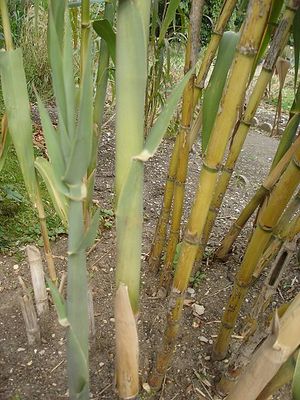Arundo donax
Arundo donax, Giant Cane, is a tall perennial cane growing in damp soils, either fresh or moderately saline. Other common names include Carrizo, Arundo, Spanish cane, Wild cane, and Giant reed.
Arundo donax is native to eastern and southern Asia, and probably also parts of Africa and the southern Arabic Peninsula. It has been widely planted and naturalized in the mild temperate, subtropical, and tropical regions of both hemispheres (Herrera & Dudley 2003), especially in the Mediterranean, California, the western Pacific, and the Caribbean. It forms dense stands on disturbed sites, sand dunes, wetlands, and riparian habitats.
Studies have found Arundo donax to be rich in active tryptamine compounds, but there are indications of the plants in India having more of these compounds than in the United States.
Invasive species
Arundo donax was introduced from the Mediterranean to California in the 1820s for roofing material and erosion control in drainage canals in the Los Angeles area. Through spread and subsequent plantings as an ornamental plant, and for use as reeds in woodwind instruments, it has become naturalized throughout warm coastal freshwaters of North America, and its range continues to spread.
It has been planted widely through South America and Australasia and in New Zealand, it is listed under the National Pest Plant Accord as an "unwanted organism".
It is among the fastest-growing terrestrial plants in the world; nearly 10 cm/ day. To present, Arundo does not provide any food sources or nesting habitats for wildlife.
Biofuel and carbon sequestration
Arundo donax is a strong candidate for use as a renewable biofuel source because of its fast growth rate, ability to grow in different soil types, and climatic conditions. A. donax will produce an average of three kilograms of biomass per square meter (25 tons per acre) once established
- More information is available at [ Wikipedia:Arundo_donax ]
Tryptamine derivatives
The best-known tryptamines are serotonin, an important neurotransmitter, and melatonin, a hormone involved in regulating the sleep-wake cycle. Tryptamine alkaloids found in fungi, plants, and animals are commonly used by humans for their psychotropic effects. Prominent examples include psilocybin (from "magic mushrooms") and DMT (from numerous plant sources, i.e. chacruna, often used in ayahuasca brews). Many synthetic tryptamines have also been made, including the migraine drug sumatriptan and its relatives.
- More information is available at [ Wikipedia:tryptamines ]
Chat rooms • What links here • Copyright info • Contact information • Category:Root
